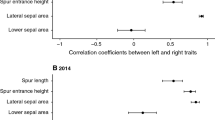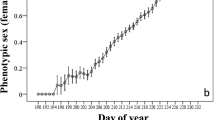Abstract
The ecological and evolutionary implications of intra-individual variation in plant traits have been acknowledged. Several studies have described the existence of intra-inflorescence variation in reproductive traits. Moreover, some of those studies have attempted to provide a plausible explanation to the gradient of intra-inflorescence variation observed. However, most of them fail to separate the effects of inflorescence architecture from those of resource allocation. The goal of this study was to determine the existence of intra-inflorescence variation in reproductive traits (attractive, reproductive organs, and reproductive success) of Conopholis alpina (Orobanchaceae), a holoparasite plant common in oak forests. Corolla length, number, viability, and diameter of pollen grains per flower, number of ovules per flower, pollen:ovule ratio, fruit size (length, width, and area), number of seeds per fruit, and seed set were measured in reproductive structures produced in three different regions within the inflorescence (i.e., bottom, middle, top). We found a significant effect of the region in which reproductive structures were produced on all traits, except pollen:ovule ratio. In all those traits in which significant differences among regions were found, reproductive traits had the highest values in the middle region of the inflorescence, which is also the first to reach maturity. Moreover, a trade-off between number of seeds and seed weight was detected on the bottom region of the inflorescence. Our results provide strong support towards the existence of differential resource availability among regions within the inflorescence as an explanation to the pattern of intra-inflorescence variation detected.



Similar content being viewed by others
References
Alonso C, Pérez R, Bazaga P, Medrano M, Herrera CM (2018) Within-plant variation in seed size and inflorescence fecundity is associated with epigenetic mosaicism in the shrub Lavandula latifolia (Lamiaceae). Ann Bot 121:153–160
Alvarado-Cárdenas L (2008) Flora del valle de Tehuacán-Cuicatlán. Fascículo 65: Orobanchaceae. Instituto de Biología, Universidad Nacional Autónoma de México, Mexico City.
Arceo-Gómez G, Vargas CF, Parra-Tabla V (2017) Selection on intra-individual variation in stigma—anther distance in the tropical tree Ipomoea wolcottiana (Convolvulaceae). Plant Biol 19:454–459
Ashman TL, Hitchens MS (2000) Dissecting the causes of variation in intra-inflorescence allocation in a sexually polymorphic species, Fragaria virginiana (Rosaceae). Am J Bot 87:197–204
Ashman TL, Pacyna J, Diefenderfer C, Leftwich T (2001) Size-dependent sex allocation in a gynodioecious wild strawberry: the effects of sex morph and inflorescence architecture. Int J Plant Sci 162:327–334
Bawa KS, Beach JH (1981) Evolution of sexual systems in flowering plants. Ann MO Bot Gard 68:254–274
Bawa KS, Webb CJ (1984) Flower, fruit and seed abortion in tropical forest trees: implications for the evolution of paternal and maternal reproductive patterns. Am J Bot 71:736–751
Brunet J (1992) Sex allocation in hermaphroditic plants. Trends Ecol Evol 7:79–84
Cao GX, Xie T, Wu BX, Yang CP (2015) Floral sex allocation and reproductive success within inflorescences of Hosta ventricosa, a pseudogamous apomict. J Plant Ecol 8:142–153
Castillo-Sánchez IL (2017) Biología reproductiva de Conopholis alpina (Orobanchaceae) en Santa Catarina Lachatao, Oaxaca. Bachelor’s thesis, Benemérita Universidad Autónoma de Puebla, Puebla, Mexico.
Centro de Estudios para el Manejo Sustentable de los Recursos Naturales, SC (CEMASREN) (1999) Resultados de manejo forestal para el aprovechamiento de recursos forestales maderables en la comunidad de Pueblos Mancomunados de Lachatao, Amatlán, Yavesía y anexos de los mismos municipios, Distrito de Ixtlán, Estado de Oaxaca, resultados del proceso de datos. Vol. II. Oaxaca, Oaxaca, Mexico.
Cruden RW (1977) Pollen-ovule ratios: a conservative indicator of breeding systems in flowering plants. Evolution 31:32–46
Dai C, Liang X, Ren J, Liao M, Li J, Galloway LF (2016) The mean and variability of a floral trait have opposing effects on fitness traits. Ann Bot 117:421–429
Diggle PK (1997) Ontogenetic contingency and floral morphology: the effects of architecture and resource limitation. Int J Plant Sci 158:S99–S107
Diggle PK (2003) Architectural effects on floral form and function: a review. Regnum Veg 3:63–80
Granado-Yela C, Balaguer L, Cayuela L, Méndez M (2017) Unusual positional effects in flower sex in an andromonoecious tree: resource competition, architectural constraints, or inhibition by the apical flower? Am J Bot 104:608–615
Guitián J, Navarro L (1996) Allocation of reproductive resources within inflorescences of Petrocoptis grandiflora (Caryophyllaceae). Can J Bot 74:1482–1486
Guitián J, Medrano M, Oti JE (2004) Variation in floral sex allocation in Polygonatum odoratum (Liliaceae). Ann Bot 94:433–440
Herrera CM (2009) Multiplicity in unity: plant subindividual variation and interactions with animals. University of Chicago Press, Chicago
Herrera CM (2017) The ecology of subindividual variability in plants: patterns, processes, and prospects. Web Ecol 17:51–64
Herrera CM, Medrano M, Bazaga P (2014) Variation in DNA methylation transmissibility, genetic heterogeneity and fecundity-related traits in natural populations of the perennial herb Helleborus foetidus. Mol Ecol 23:1085–1095
Hiraga T, Sakai S (2007) The effects of inflorescence size and flower position on biomass and temporal sex allocation in Lobelia sessiliflora. Plant Ecol 188:205–214
Instituto Nacional de Estadística, Geografía e Informática (INEGI) (2005) Prontuario de Información Geográfica Municipal de los Estados Unidos Mexicanos: Santa Catarina Lachatao, Oaxaca. https://www3.inegi.org.mx/contenidos/app/mexicocifras/datos_geograficos/20/20365.pdf Accessed 31 Jan 2019
Ishii HS, Sakai S (2002) Temporal variation in floral display size and individual floral sex allocation in racemes of Narthecium asiaticum (Liliaceae). Am J Bot 89:441–446
Kearns CA, Inouye DW (1993) Techniques for pollination biologists. University Press of Colorado, Niwot
Kliber A, Eckert CG (2004) Sequential decline in allocation among flowers within inflorescences: proximate mechanisms and adaptive significance. Ecology 85:1675–1687
Kudo G, Maeda T, Narita K (2001) Variation in floral sex allocation and reproductive success within inflorescences of Corydalis ambigua (Fumariaceae): pollination efficiency or resource limitation? J Ecol 89:48–56
Kulbaba MW, Clocher IC, Harder LD (2017) Inflorescence characteristics as function-valued traits: analysis of heritability and selection on architectural effects. J Syst Evol 55:559–565
Lloyd DG (1980) Sexual strategies in plants I. A hypothesis of serial adjustment of maternally investment during one reproductive session. New Phytol 86:69–79
Lloyd DG, Webb CJ, Primack RB (1980) Sexual strategies in plants. II. Data on the temporal regulation of maternal investment. New Phytol 86:81–92
Medrano M, Guitián P, Guitián J (2000) Patterns of fruit and seed set within inflorescences of Pancratium maritimum (Amaryllidaceae): nonuniform pollination, resource limitation, or architectural effects? Am J Bot 87:493–501
Mossop R, Macnair MR, Robertson W (1994) Within-population variation in sexual resource allocation in Mimulus guttatus. Funct Ecol 8:410–418
Ordano M, Tejada KA, Benavídez A (2011) Caracterización de la variación intra-individual en tamaño y forma del fruto en Psychotria carthagenensis Jacq. (Rubiaceae). Lilloa 48:189–204
Rice WR (1989) Analyzing tables of statistical tests. Evolution 43:223–225
Rzedowski G (1998) Flora del bajío y de regiones adyacentes. Fascículo 69: Orobanchaceae. Instituto de Ecología, A.C. Centro Regional del Bajío, Pátzcuaro, Michoacán, Mexico.
Seifi E, Guerin J, Kaiser B, Sedgley M (2008) Inflorescence architecture of olive. Sci Hort 116:273–279
Simons AM, Johnston MO (2000) Variation in seed traits of Lobelia inflata (Campanulaceae): sources and fitness consequences. Am J Bot 87:124–132
Soejarto D, Fonnegra R (1972) Polen: diversidad en formas y tamaños. Actu Biol 1:1–13
Thomson JD (1989) Deployment of ovules and pollen among flowers within inflorescences. Evol Trend Plant 3:65–66
Torices R, Méndez M (2014) Resource allocation to inflorescence components is highly integrated despite differences between allocation currencies and sites. Int J Plant Sci 175:713–723
Unidad de Manejo Forestal (UMAFOR) (2007) Estudio regional forestal para el fortalecimiento de las Unidades de Manejo Forestal en la Sierra Norte Oaxaca. Fondo CONAFOR-CONACYT, Comisión Nacional Forestal (CONAFOR)
Wesselingh RA, Arnold M (2003) A top-down hierarchy in fruit set on inflorescences in Iris fulva (Iridaceae). Plant Biol 5:651–660
Zhang G, Xie T, Du G (2012) Variation in floral sex allocation, female success, and seed predation within racimiform synflorescence in the gynomonoecious Ligularia virgaurea (Asteraceae). J Plant Res 125:527–538
Zhao Z-G, Liu Z-J, Conner JK (2015) Plasticity of floral sex allocation within inflorescences of hermaphrodite Aconitum gymnandurm. J Plant Ecol 8:130–135
Acknowledgements
The authors thank the community of Santa Catarina Lachatao in Oaxaca for allowing us to conduct this study in their locality. Juan Hernández and Verónica Hernández were very supportive during logistics and field work. Arturo Casasola-González, Mario Pérez, Sandra Aguilar-García, Luis Padilla, Samantha de los Santos, Laura de Sampedro, Silvia Cruz, Paula Marcos, Alexa Hernández, Diego Hernández, Leslie Marcos, Eva Marcos, Sofía Hernández, Roberto Hernández, Ramiro Santiago, and Armando Santiago were very helpful during field work. Sandra Aguilar-García helped to standardize the protocol for the acetolysis procedure. Arelee Muñoz, Karla López, Xiumy Sánchez, and Alicia Elvira assisted at processing samples in the laboratory. Members of the Hystophysiology laboratory at Facultad de Ciencias Biológicas from Benemérita Universidad Autónoma de Puebla (BUAP) allowed the use of their facilities to conduct the acetolysis procedure. Recommendations from Professor Marcos Méndez and an anonymous reviewer significantly improved the manuscript. This study was supported by Vicerrectoría de Investigación y Estudios de Posgrado (VIEP) from Benemérita Universidad Autónoma de Puebla (Grant Number: FICD-NAT17-I) to D.M. F.-C.
Author information
Authors and Affiliations
Corresponding author
Additional information
Communicated by Philip Ladd.
Publisher's Note
Springer Nature remains neutral with regard to jurisdictional claims in published maps and institutional affiliations.
Rights and permissions
About this article
Cite this article
Castillo-Sánchez, I.L., Figueroa-Castro, D.M. Intra-inflorescence variation in reproductive traits of Conopholis alpina (Orobanchaceae): effect of flower maturation pattern and resource competition. Plant Ecol 220, 721–729 (2019). https://doi.org/10.1007/s11258-019-00947-8
Received:
Accepted:
Published:
Issue Date:
DOI: https://doi.org/10.1007/s11258-019-00947-8




